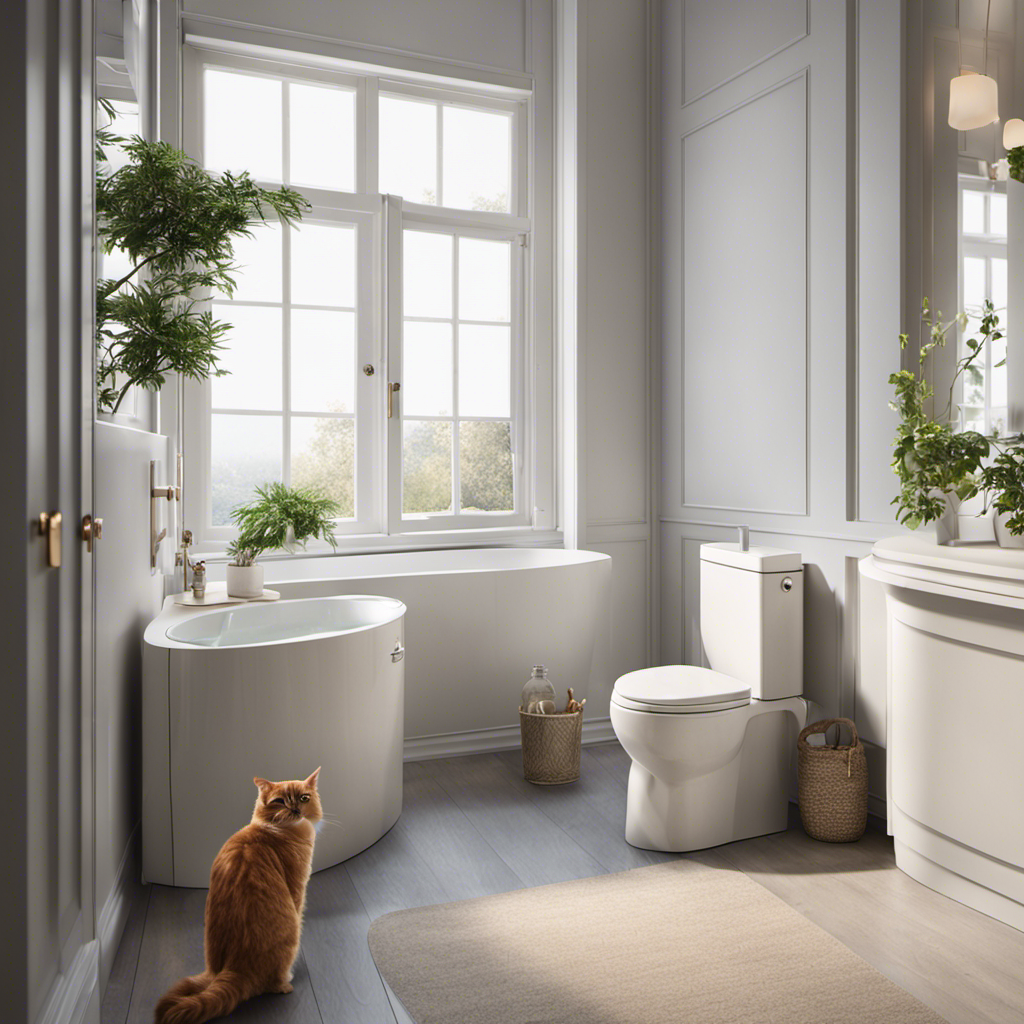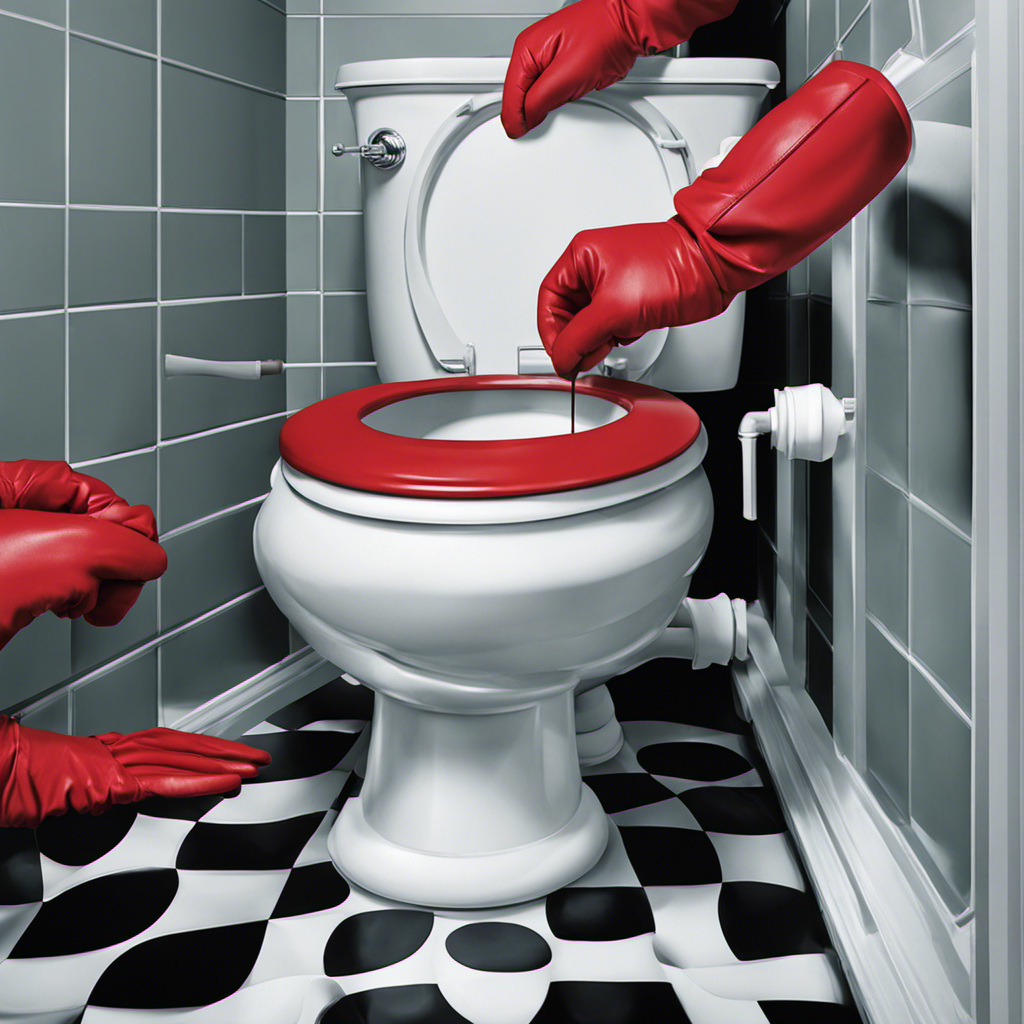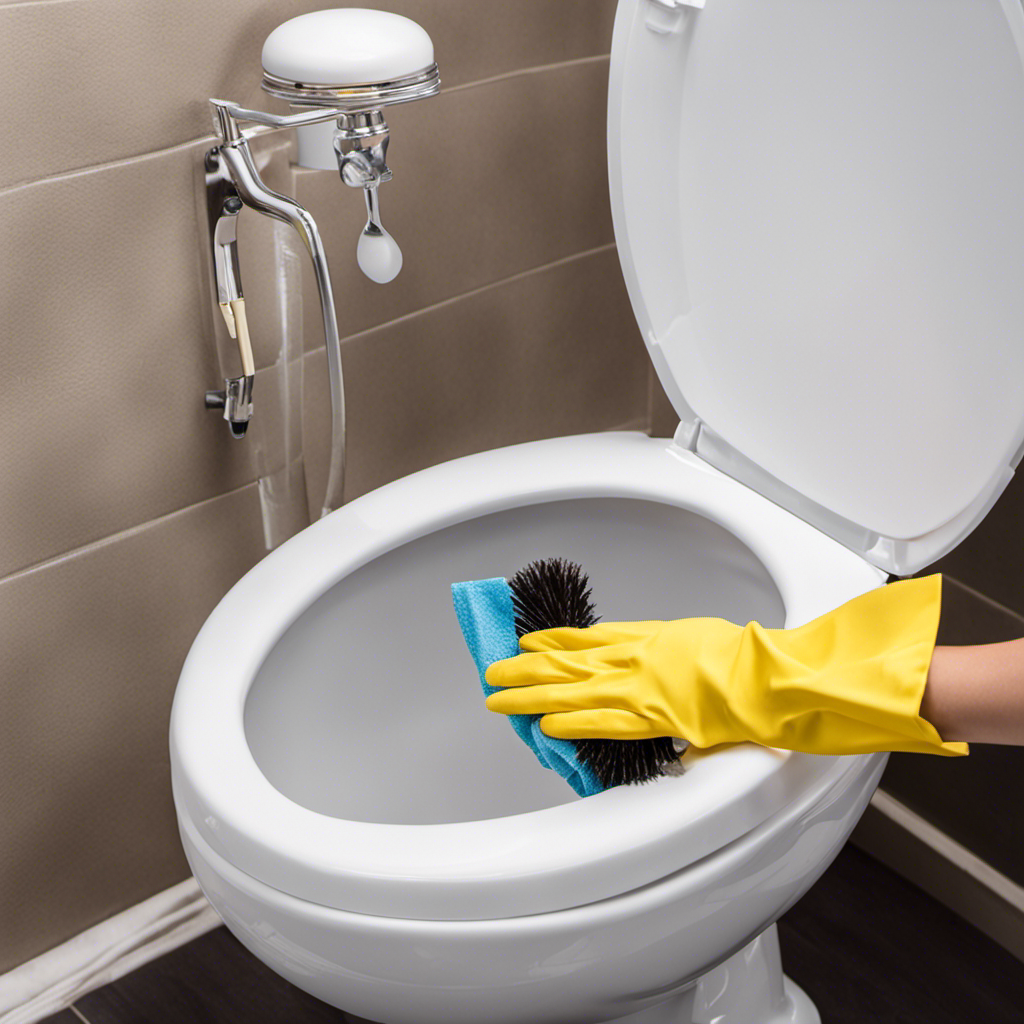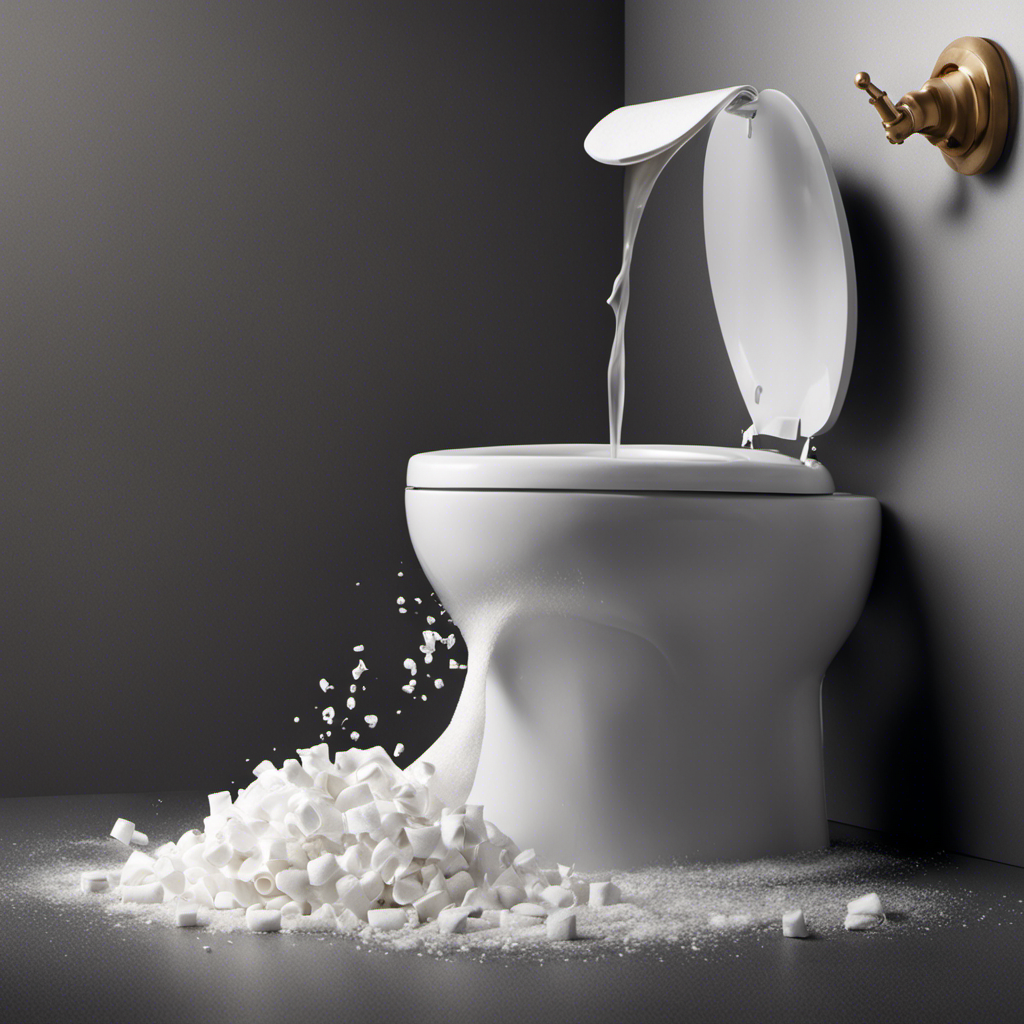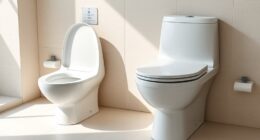As a cat owner, I’ve always dreamed of a world where litter boxes are a thing of the past. Imagine a clean, odor-free bathroom, devoid of scattered litter and the constant chore of scooping.
Well, my friends, that dream can become a reality. In this article, I’ll guide you through the step-by-step process of training your feline companion to use the toilet.
With a little patience and perseverance, you’ll soon bid farewell to the litter box and say hello to a more convenient and hygienic way of life.
Key Takeaways
- Toilet training eliminates the need for a litter box and reduces associated odor and litter tracking.
- Choosing the right method, whether gradual transition or litter-free, is essential for successful training.
- Preparing the cat and the bathroom for toilet training involves gathering necessary tools and creating a comfortable environment.
- Litter box alternatives, such as toilet training kits, offer convenience, cleanliness, and long-term cost savings.
Step 1: Understanding the Benefits of Toilet Training for Cats
First, you should understand the benefits of toilet training your cat. While it may seem like a daunting task, the rewards are worth it.
One of the main benefits is eliminating the need for a litter box. This not only saves you the hassle of cleaning it regularly, but also eliminates the odor associated with traditional litter boxes.
Additionally, toilet trained cats are less likely to track litter throughout your home, keeping it cleaner and more hygienic.
Another advantage is the cost savings. By eliminating the need for litter, you can save a significant amount of money over time.
Lastly, toilet training can help address certain toilet training challenges, such as cats refusing to use the litter box or experiencing litter aversions. By using litter alternatives, such as specially designed toilet training kits, you can overcome these challenges and successfully train your cat to use the toilet.
Step 2: Choosing the Right Toilet Training Method for Your Cat
Next, you’ll want to select the most suitable method to teach your furry friend to use the bathroom. Choosing the right method is crucial for successful toilet training.
There are a few different approaches you can consider. One option is the gradual transition method, where you start by placing a litter box on top of the toilet and gradually raise it over time. Another option is the litter-free method, where you use a specialized training seat that fits onto the toilet bowl.
Whichever method you choose, it’s important to track your training progress. Keep a record of your cat’s successes and setbacks to identify any patterns and make necessary adjustments. By monitoring your cat’s progress, you can ensure a smooth and effective toilet training experience.
Now, let’s move on to step 3: preparing your cat and the bathroom for toilet training.
Step 3: Preparing Your Cat and the Bathroom for Toilet Training
When it comes to toilet training your cat, there are a few alternatives to the traditional litter box that you can consider. I will discuss these options in detail and provide insights on their pros and cons.
Additionally, I will explain the training tools you will need to successfully teach your cat to use the toilet, such as training seats and treats.
Lastly, I will share tips on how to set up your bathroom to create a comfortable and inviting environment for your cat during the toilet training process, including suggestions on litter placement and odor control.
Litter Box Alternatives
If you’re looking for an alternative to the traditional litter box, consider using a toilet training kit for your cat. Not only does it eliminate the need for litter and the hassle of cleaning the box, but it also provides a more hygienic option for your furry friend.
Here are four reasons why a toilet training kit may be a great choice for your cat:
-
Convenience: With a toilet training kit, you can say goodbye to scooping litter and dealing with unpleasant odors. Simply flush and move on with your day.
-
Space-saving: No more bulky litter boxes taking up precious floor space in your home. A toilet training kit allows you to utilize your existing bathroom fixtures.
-
Cost-effective: While initial investment may be higher, in the long run, you’ll save money on purchasing litter and cleaning supplies.
-
Regression prevention: If you have an older cat who is experiencing toilet training regression, a toilet training kit can help reinforce good habits and alleviate any issues they may be having.
Overall, toilet training kits offer a practical and efficient alternative to traditional litter boxes, making them a worthwhile consideration for any cat owner.
Training Tools Needed
One essential tool you’ll need for toilet training a cat is a toilet training kit. These kits usually include a special training seat that fits on top of your toilet, along with step-by-step instructions on how to train your cat to use the toilet.
There are different training methods you can use, such as gradually raising the litter box height and introducing the training seat, or using a special training disc that fits inside the toilet bowl.
Toilet training your cat offers many benefits, including eliminating the need for a litter box, reducing odors, and saving money on litter. It also eliminates the hassle of cleaning and maintaining a litter box.
With the right tools and training methods, your cat can become a pro at using the toilet in no time.
Now, let’s move on to some bathroom setup tips to ensure successful toilet training.
Bathroom Setup Tips
Setting up your bathroom properly is crucial for successful toilet training. Here are four tips to create an ideal environment for your cat’s toilet training progress:
-
Remove distractions: Clear any clutter or items that may distract your cat during their bathroom time. A clean and calm space will help them focus on the task at hand.
-
Provide easy access: Ensure that the litter box or toilet seat adapter is easily accessible for your cat. This will encourage them to use it without any difficulties or obstacles.
-
Use consistent cues: Place the litter box or adapter in the same spot each time, and use consistent cues, such as verbal commands or visual markers, to signal bathroom time. This will help establish a toilet training schedule and reinforce the desired behavior.
-
Maintain cleanliness: Regularly clean the litter box or toilet seat adapter to keep the bathroom area fresh and odor-free. Cats are more likely to use a clean and inviting space.
By following these tips, you can set the stage for successful toilet training progress.
Now, let’s move on to the next step: introducing your cat to the toilet.
Step 4: Introducing Your Cat to the Toilet
Once your cat is comfortable using the litter box, you can start introducing them to the toilet. This step requires patience and consistency.
Begin by placing a special training seat on top of the toilet, designed specifically for cats. It is essential to make this transition slowly to avoid overwhelming your cat. Start by placing the litter box next to the toilet and gradually raise it to the same level as the toilet seat. This helps your cat associate the toilet with their bathroom routine.
Introduce rewards, such as treats or praise, to encourage your cat’s progress. However, accidents may happen during the training process. If your cat has an accident, remain calm, clean it up, and continue with the training. Remember, accidents are part of the learning process, and with time, your cat will successfully use the toilet.
Step 5: Teaching Your Cat to Use the Toilet Seat
After successfully introducing your cat to the toilet, it’s time to move on to the next step: teaching your cat to use the toilet seat. This is an important part of the toilet training progress as it helps your cat become familiar with the idea of eliminating waste in the toilet.
Here are some tips to help you in teaching cats new behaviors:
-
Start by placing a training seat on top of the toilet bowl. This seat has a hole in the middle, allowing your cat to balance comfortably.
-
Gradually remove the litter box from the bathroom, so your cat starts associating the toilet as the only place to eliminate waste.
-
Encourage and reward your cat each time they use the toilet seat. This positive reinforcement will reinforce the desired behavior.
-
Be patient and consistent in your approach. It may take time for your cat to fully adapt to using the toilet for elimination.
Now that your cat is comfortable using the toilet seat, let’s move on to step 6: gradually eliminating the litter box.
Step 6: Gradually Eliminating the Litter Box
As you continue the training process, you’ll need to gradually remove the litter box from the bathroom to encourage your cat to rely solely on the toilet for elimination. This gradual transition is an important step in teaching your cat to use the toilet independently.
Start by moving the litter box slightly further away from the toilet each day. You can place it in a nearby room or hallway as a temporary solution. This allows your cat to become accustomed to using the toilet without the presence of the litter box.
Once your cat is consistently using the toilet, you can completely phase out the litter box. Remember to be patient during this process and reward your cat with praise and treats for successful toilet usage.
With time and consistency, your cat will become a pro at using the toilet!
Step 7: Troubleshooting Common Toilet Training Issues
Eliminating outside the toilet and the fear of falling in are two common issues that cat owners may encounter when toilet training their feline friends.
When a cat eliminates outside the toilet, it could be due to a variety of reasons such as a lack of understanding or discomfort with the new setup. To address this, it is important to provide positive reinforcement and gradually transition the cat to using the toilet.
Additionally, some cats may develop a fear of falling in, especially if they have had a negative experience or lack confidence. This fear can be overcome through patience, reassurance, and the use of training aids such as a secure litter tray or a step-up platform.
Eliminating Outside the Toilet
To avoid accidents, it’s important to gradually transition your cat from eliminating outside the toilet to using the toilet itself. This process requires patience and consistency.
Here’s a step-by-step guide to help you through this stage of toilet training:
-
Minimize outside distractions: Create a calm and quiet environment in the bathroom where your cat can focus on using the toilet. Remove any toys, food bowls, or other distractions that may divert their attention.
-
Establish a training schedule: Set specific times throughout the day for your cat to use the toilet. Consistency is key in reinforcing the desired behavior. Start with shorter sessions and gradually increase the duration over time.
-
Use positive reinforcement: Reward your cat with treats or praise every time they successfully eliminate in the toilet. This positive reinforcement will help them associate the toilet with a positive experience.
-
Monitor progress: Keep track of your cat’s progress and adjust your training approach accordingly. If accidents occur, remain patient and continue with the training process. With time and consistency, your cat will eventually become comfortable using the toilet.
Fear of Falling in
Don’t worry, you’ll gradually help your cat overcome the fear of falling in the toilet. Cats can be naturally cautious creatures, and it’s common for them to feel anxious about using the toilet.
The key to overcoming this fear is to create a safe and positive environment for your cat. Start by placing a litter box next to the toilet, allowing your cat to get used to the idea of using the bathroom in that area. Gradually raise the litter box, using stable platforms or boxes, until it is at the same height as the toilet seat. This will help your cat feel more comfortable with the height and reduce their anxiety.
Building trust is essential in this process, so make sure to reward your cat with treats and praise every time they successfully use the litter box. With patience and consistency, your cat will soon conquer their fear and confidently use the toilet.
Conclusion
In conclusion, toilet training a cat may seem like a daunting task, but with patience and perseverance, it can be achieved. By understanding the benefits of toilet training and choosing the right method for your feline friend, you can successfully transition them from a litter box to the toilet.
Remember to prepare both your cat and the bathroom for the training process, and gradually introduce them to the toilet seat. With consistent training and troubleshooting any issues that may arise, you’ll soon have a toilet-trained cat, eliminating the need for a litter box altogether.
So why not give it a try and enjoy the convenience and cleanliness of a cat using the toilet?
